 Native American Indian tribes lived in the territory of US and Canada long before the conquistadors. They lived in harmony with nature. That's why their culture is closely related with the laws of nature. Native Americans made their garments from animal skins and fur, bark of trees and other materials which they gained hunting and gathering. They used sinew as threads, made jewelry from wood, shells and stones, embellished clothes with beads and patterns on fabric. Native American Indian tribes survived in Alaska and in desert areas, in thick forests and in mountainous regions. They could understand the nature, respect it and use its gifts.
Native American Indian tribes lived in the territory of US and Canada long before the conquistadors. They lived in harmony with nature. That's why their culture is closely related with the laws of nature. Native Americans made their garments from animal skins and fur, bark of trees and other materials which they gained hunting and gathering. They used sinew as threads, made jewelry from wood, shells and stones, embellished clothes with beads and patterns on fabric. Native American Indian tribes survived in Alaska and in desert areas, in thick forests and in mountainous regions. They could understand the nature, respect it and use its gifts.
As Native Americans respected nature and tried to protect it, so they had a habit to use gifts of nature entirely. When they hunted an animal, they took meat, skin, fur, bones, tendons, even teeth and claws. Nothing was thrown away. Every part of the animal was useful for people, helped them to survive. Meat for dinner, hides to make clothes, bones to make jewelry and tools, feathers for headdresses etc.
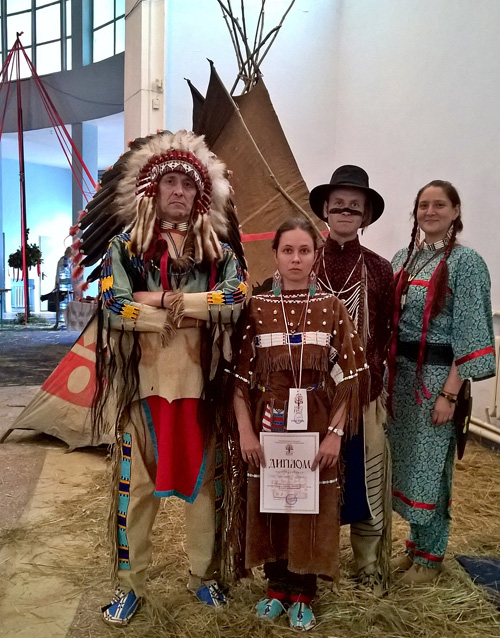
Reconstruction of traditional costumes of Native American Indians
The Native American Indians made clothing from such animals as buffalo, deer, bear, rabbit, elk, moose, weasel, wildcats, otter, ermine, fish (skins) and snake (skin). They used leather, fur, bones, feathers, teeth, claws and other parts of animals which they hunted.
The Native American also used plants to make their clothes. They took a bark of trees, dried, shredded, and made fibers of bark to weave cloth. Different tribes used bark of the sagebrush, spruce roots, bear grass and wildrye grass.
Native Americans were really good in making garments from animal hides. Their clothes were warm, natural, beautiful and convenient.
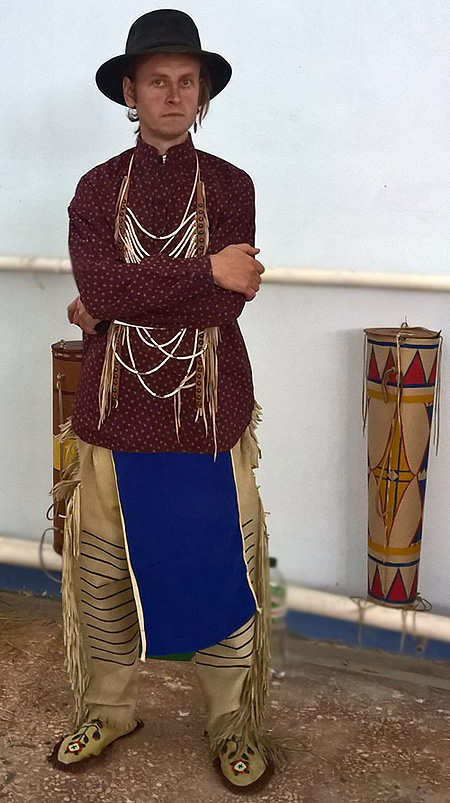
Reconstruction of traditional men's clothing of Native American Indians
But also they knew how to make cloth. Weaving was one of crafts popular among Native American Indians. They grew cotton and wove cloth from it. The tribe Hopi did so. Other tribes (like Haida and Tsimshian) wove cloth from mountain-sheep wool and mountain-goat hair. The tribe Cherokee could weave cloth from mulberry bark.
Men's clothing of Native Americans. Men usually wore a breechclout or breechcloth (a long rectangular piece of cloth or hide worn with a belt) and leggings, fur trousers or short kilt. Sometimes they used shirts. Leather shoes called "moccasins" or boots called "mukluks" complemented the costume. The festive or war headgear was made from feathers and called "war bonnet". In winter Native Americans used cloaks and fur parkas.
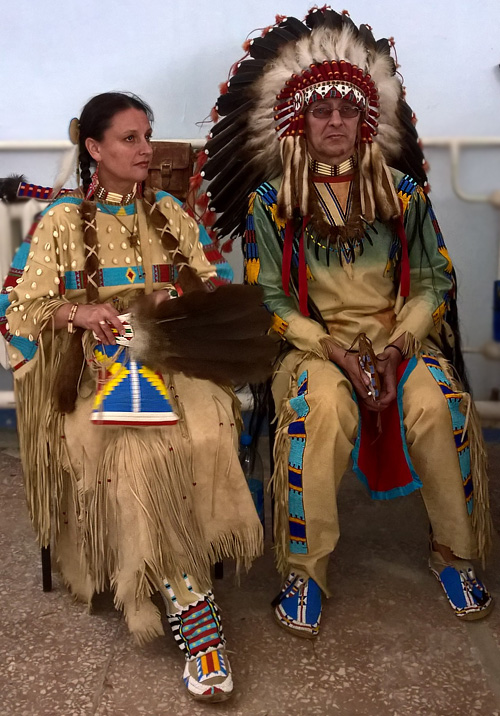
Reconstruction of festive men's and women's costumes of Native American Indians
Women's clothing of Native Americans. Female costume consists of a skirt, leggings, a shirt (for some tribes it is optional), a tunic or mantle, shoes (moccasins or mukluks). Sometimes women used a dress instead of skirts and shirts. Women also wore cloaks and fur parkas in cold weather.
Parts of Native American costume
And now let's talk a little bit about certain pieces of clothing used by the Native Americans.
Adv just for you
Looking for one-of-a-kind accessory? Here are beautiful hand-embroidered bracelets with patterns 100-150 years old. These needlework designs are from Ukrainian authentic embroidered clothing and ceremonial towels. But the wristbands look very modern and casual. They can be great statement accessories!
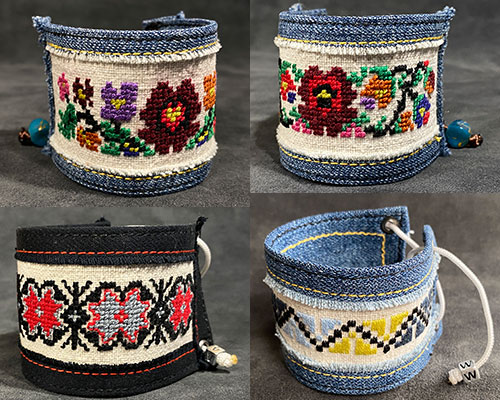
Price: only $15.
Buy embroidered bracelets now!
War shirt
It is a ceremonial tunic worn for ceremonies and rituals. Very seldom such shirts were worn for war purposes. War shirt was always very festive and embellished, decorated with beadwork, pictures on fabric (or leather), fringes, feathers, human scalps and other decorative elements. As war shirts weren't used for battles, though the shirt itself showed the courage of the warrior. The pictures reflected moments of a battle, scalps showed the number of killed enemies etc. Only the bravest warriors were granted the honor of wearing a war shirt for a ceremony. Native American Indians believed that such garments protected their wearer and gave him more strength and bravery.
Usually war shirts were made from a deerskin or a hide of mountain sheep. Every tribe had its own typical symbols and pictures on war shirts (like vertical lines, triangles, horses etc).
Buckskin clothing (Buckskins)
These are garments made from deerskin (usually smoked). Moose, elk, and caribou skins were used as well. The color of Buckskins is yellow or grayish, and it depends on the wood used during smoking. Such clothing is warm, convenient and hard-wearing. Native Americans made different pieces of attire from deerskin: shirts, dresses, leggings, cloaks, moccasins, belts, bags, breechcloths etc.
Before a hide turned into clothing it had to undergo several important processes: removing from the animal, de-hairing, scraping, smoking, softening, stretching, dyeing, and decorating. When the leather was soft enough to make a garment, it was cut to the needed shape and sewn with sinew.
Buckskin clothing was among favorite costumes of Native American Indians. And after colonizers came, such clothes didn't loose its popularity. It was used by people in America for years.
Fur parka
A fur parka is a very convenient piece of clothing for cold weather. It is a knee-long coat with hood made from animal skin and fur. Usually such parkas are sewn with fur inside and fur fringe or ruff attached to the hem, cuffs and hood. To make a parka Native American Indians used fur of Arctic wolf or Arctic fox, wolverine, coyote, husky dog; for the trim white fur of the caribou's belly was used.
Fur parkas were used by such tribes as Yupik, Inuit and other tribes who lived in regions with severe weather conditions. In Alaska people often used 1 or 2 inner parkas to survive in winter. Women's parkas were large and with elongated hoods, they were designed to let a woman carry her baby or infant next to her body.
Inuit people believed that parkas provided spiritual protection from predators or other danger. That's why Inuit parkas were decorated with symbols of wild animals for protection.
Breechclout (breechcloth)
It is a rectangular piece of cloth or skin worn around the hips. Breechclout was the most widespread part of Native American traditional costume. The usual size of it was about 50 inches long and 8-10 inches wide. It could be made from bark fiber, buckskin, skins of deer, beaver, raccoon, rabbit, buffalo etc. A breechcloth was fixed on the waist or hips with a help of a belt or throng.
Both men and women used breechcloths. Men wore only this piece in summer, and added leggings during colder seasons. Sometimes a breechclout was worn with a decorated apron on top. Women rarely used a breechcloth. Mostly young girls did. Some women sometimes wore it beneath a dress.
War bonnet
It is a traditional headdress of Native American Indians. War bonnet was used by the war leaders, chiefs and great warriors. This headgear was a reflection of the warrior's bravery and courage or chief's wisdom. Every feather was given to the owner of a war bonnet for a certain brave deed in a battle or for his tribe. The number of feathers showed the courage and respect to the leader.
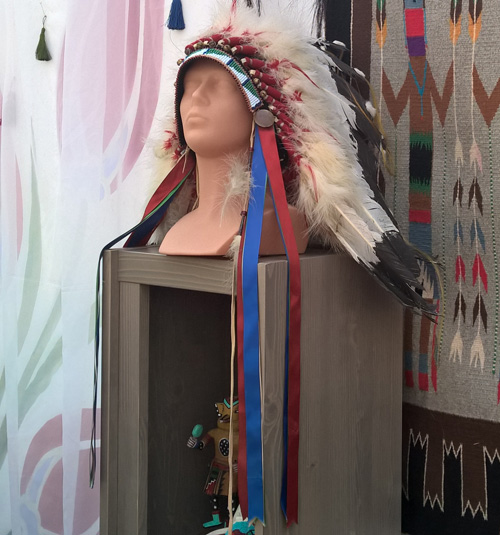
War bonnet of Native Americans
Every tribe had its own traditions of making and wearing a war bonnet. Different shapes, decorations, design, and style. There are many kinds of war bonnets including long trailing feathered war bonnet, buffalo horn headdresses, straight-up feathered war bonnets, the crown and plume war bonnets, halo war bonnets.
Roach headdress
Native American warriors wore roach headdresses with war paint for battles. It was made to intimidate enemy. A lot of tribes used roach headdresses including Omaha, Mohawk, Sauk, Fox, Osage, Ponca, Pequot, Kansa, Lenape (Delaware), Crees, Huron and the Pawnee.
Roach headdress was worn the following way. The warrior shaved his hair leaving a "scalp lock"; it was a long lock of hair at the back side of the head. The roach was attached to this hair. It looked like a crest of hair, something like a modern mohawk. A roach-spreader was used to hold the hair. The roach headdress was fixed by a special pin or tied by laces to the head and neck.
The roach headdress was usually made from moose hair, porcupine guard hair, turkey beard hair and white deer-tail hair. And it was embellished with feathers and other decorative elements.
Mukluks (Kamiks or Eskimo boots)
These are worm fur boots, supple and knee-high. They are made from caribou skin, sealskin or reindeer skin. Such boots were worn by Native American Indians in the North of America, in Alaska and other cold territories. Such tribes as Aleut, Inuit and Yupik were making and using mukluks.
Mukluks were made of leather and decorated with fur (squirrel, bear or beaver). Threads are replaced by caribou sinew. These boots were made by women of the tribe. Each woman sewed mukluks for her family. There are many stages of making boots: cutting, scraping, softening, working the skins, sewing, decorating with embellishments (painting, cutting and sewing symbols, decorating with beads, making tassels and pom-poms). Baby's mukluks are made with fur inside.
Moccasins
These are shoes of Native American Indians worn in summer. They were usually made from soft leather (caribou, deer, moose, buffalo or elk), but in different tribes various materials could be used. The sole and upper part are usually one piece. Such shoes are very convenient, comfortable and good for hunting and war (because they help to walk silently). Tribes who lived in cold regions, in mountainous and desert areas used moccasins with thick soles. Those who lived in forests didn't need that.
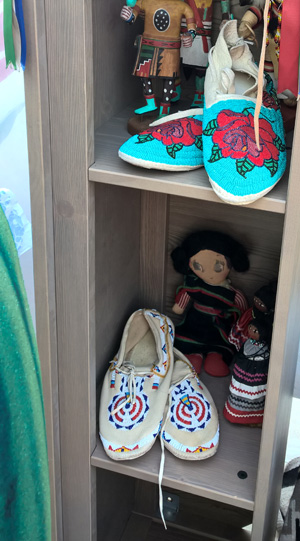
Traditional American moccasins
Men, women and children used moccasins. There are many designs of these shoes, they differ from tribe to tribe. Women sometimes wore simple moccasins – they wrapped legs with heavy strips of buckskin from the ankle to the knee. Also sometimes people made warm moccasins adding the rabbit fur.



HE HAD A WORKSHOP IN RAPID CITY AND CREATED BEAUTIFUL LEATHERWORK AND BEADWORK ON BUFFALO HIDES...MY JOURNEY HAS BEEN INTERESTEING BUT NOW I COME FULL CIRCLE BACK TO MY HEART AND ROOTS! PLEASE HELP IF YOU CAN.
I NOW LIVE IN FT. COLLINS, CO...STANLEY LOOKING HORSE PUT ME ON MY FIRST Haŋblečeya...Mitakoyacin!
Sorry, we can't help you right now, but maybe someone will in the comments.
Thank you.
))) Of course, Native Americans didn't wear glasses. But people on the photo are just sort of historical reconstructors)
There must be a mistake....i guess!
Regards,